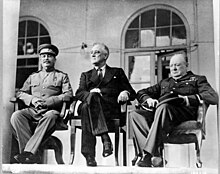
Back الاتحاد السوفيتي في الحرب العالمية الثانية Arabic Съветският съюз във Втората световна война Bulgarian Unión Soviética en la Segunda Guerra Mundial Spanish اتحاد جماهیر شوروی در جنگ جهانی دوم Persian Union soviétique dans la Seconde Guerre mondiale French ברית המועצות במלחמת העולם השנייה HE ԽՍՀՄ-ը Երկրորդ համաշխարհային պատերազմում Armenian Uni Soviet pada Perang Dunia II ID Unione Sovietica nella seconda guerra mondiale Italian Екінші Дүниежүзілік соғыстағы КСРО Kazakh



| Part of a series on the |
| History of the Soviet Union |
|---|
 |
|
|
After the Munich Agreement, the Soviet Union pursued a rapprochement with Nazi Germany. On 23 August 1939, the Soviet Union signed a non-aggression pact with Germany which included a secret protocol that divided Eastern Europe into German and Soviet spheres of influence, anticipating potential "territorial and political rearrangements" of these countries.[2] Germany invaded Poland on 1 September 1939, starting World War II. The Soviets invaded eastern Poland on 17 September.[3] Following the Winter War with Finland, the Soviets were ceded territories by Finland. This was followed by annexations of the Baltic states and parts of Romania.
On 22 June 1941, Adolf Hitler launched Operation Barbarossa, an invasion of the Soviet Union with the largest invasion force in history, leading to some of the largest battles and most horrific atrocities. This offensive comprised three army groups. The city of Leningrad was besieged while other major cities fell to the Germans. Despite initial successes, the German offensive ground to a halt in the Battle of Moscow, and the Soviets launched a counteroffensive, pushing the Germans back. The failure of Operation Barbarossa reversed the fortunes of Germany, and Stalin was confident that the Allied war machine would eventually defeat Germany.[4] The Soviet Union repulsed Axis attacks, such as in the Battle of Stalingrad and the Battle of Kursk, which marked a turning point in the war. The Western Allies provided support to the Soviets in the form of Lend-Lease as well as air and naval support. Stalin met with Winston Churchill and Franklin D. Roosevelt at the Tehran Conference and discussed a two-front war against Germany and the future of Europe after the war. The Soviets launched successful offensives to regain territorial losses and began a push to Berlin. The Germans unconditionally surrendered in May 1945 after Berlin fell.
The bulk of Soviet fighting took place on the Eastern Front—including the Continuation War with Finland—but it also invaded Iran in August 1941 with the British. The Soviets later entered the war against Japan in August 1945, which began with an invasion of Manchuria. They had border conflicts with Japan up to 1939 before signing a non-aggression pact in 1941. Stalin had agreed with the Western Allies to enter the war against Japan at the Tehran Conference in 1943 and at the Yalta Conference in February 1945 once Germany was defeated. The entry of the Soviet Union in the war against Japan along with the atomic bombings by the United States led to Japan's surrender, marking the end of World War II.
The Soviet Union suffered the greatest number of casualties in the war, losing more than 20 million citizens, about a third of all World War II casualties. The full demographic loss to the Soviet people was even greater.[5] The German Generalplan Ost aimed to create more Lebensraum (lit. 'living space') for Germany through extermination. An estimated 3.5 million Soviet prisoners of war died in German captivity as a result of deliberate mistreatment and atrocities, and millions of civilians, including Soviet Jews, were killed in the Holocaust. However, at the cost of a large sacrifice, the Soviet Union emerged as a global superpower.[6] The Soviets installed dependent communist governments in Eastern Europe, and tensions with the United States and the Western allies grew to what became known as the Cold War.[7]
- ^ McNab, Chris (2017). German Soldier vs Soviet Soldier: Stalingrad 1942–43. Osprey PUBLISHING. p. 66. ISBN 978-1472824561.
- ^ chathamhouse.org, 2011
- ^ Goldman 2012, pp. 163–164.
- ^ Pearson, Clive (December 2008). "Stalin as War Leader". History Review 62. History Today. Retrieved 5 December 2017.
- ^ Geoffrey A. Hosking (2006). Rulers and victims: the Russians in the Soviet Union. Harvard University Press. p. 242. ISBN 0-674-02178-9
- ^ Reiman, Michael (2016). "The USSR as the New World Superpower". About Russia, Its Revolutions, Its Development and Its Present. Peter Lang. pp. 169–176. ISBN 978-3-631-67136-8. JSTOR j.ctv2t4dn7.14.
- ^ Bunce, Valerie (1985). "The Empire Strikes Back: The Evolution of the Eastern Bloc from a Soviet Asset to a Soviet Liability". International Organization. 39 (1). The MIT Press: 1–46. doi:10.1017/S0020818300004859. JSTOR 2706633. S2CID 154309589.